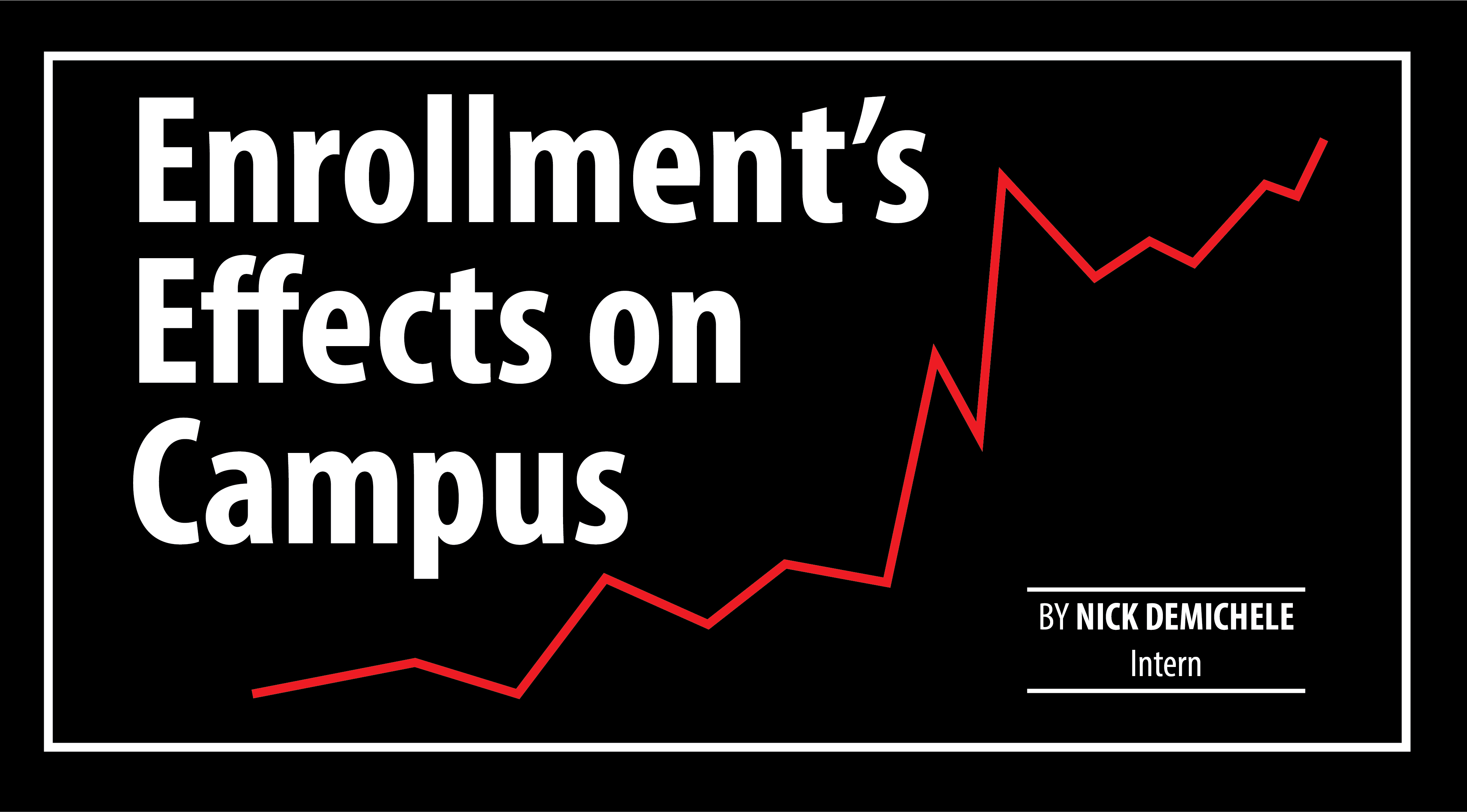Enrollment’s Effects on Campus
Students at Frostburg State University may be surprised to hear that they aren’t the only ones who occasionally encounter issues during the biannual registration period. While students often struggle to get in the classes they need, faculty sometimes have difficulty receiving enough students in their classes. Enrollment, while an issue at virtually all institutions of higher-education, plays a particularly important role at smaller institutions like Frostburg State.
Here at FSU, faculty must complete a required amount of “work load units.” The University System of Maryland mandates that all full-time faculty members complete a total of 24 work load units per academic year. With one work-load unit usually equalling one credit, this optimally equates to 12 work load units per academic semester. However, this is not always the case.
The amount of work-load units allocated to faculty are determined by enrollment in a specific course. In 2004, the Faculty Senate at FSU passed guidelines that determine the number of students required in a course to to satisfy particular units. For example, the guidelines state that courses with eight or fewer students will only merit 0.83 work load units, while classes with 9-45 students merit 3.0 work load units. Faculty have an opportunity to earn more units when more than 45 students are enrolled in a course. These guidelines are available within the Faculty Handbook, hosted on the Frostburg website.
Associate Provost Dr. Randall Rhodes, who chaired the Faculty Senate when these guidelines were passed, explains that “in traditional departments with mostly three credit courses,” work-load unit distribution isn’t typically a large issue. However, in departments that feature more labs, seminars, and small sections of courses, it is not uncommon to see fractions of work load units, which can add to a faculty member’s list of courses to teach.
Faculty that are unable to complete their normal twelve work load units in the fall semester are required to make up these units in the spring. However, faculty that exceed the established 24 requirement are not automatically paid an additional amount, as faculty receive a set salary every year.
Technically, university policy outlines forms of compensation for those who exceed these 24 units per year. As an institution, however, FSU has historically been unable to fund such compensation.
Dr. Rhodes did say, however, that once work load units reach a “certain threshold,” additional courses are considered for “overload” compensation. This occurs through the offices of the individual deans across campus, where a holistic approach and evaluation of individual circumstances occurs.
The Bottom Line was able to reach the Dean of the College of Liberal Arts and Sciences (CLAS), Dr. Joseph Hoffman, for elaboration on both work load unit policies and implementation, as well as compensation.
Dr. Hoffman describes the relationship between enrollment and work load units as somewhat complex. To begin, certain programs encounter unique challenges concerning work load units. For example, the music department routinely features private lessons as part of the structure of the department. Depending on the number of students receiving these lessons during any given semester, a formula based upon this enrollment is used to generate the work load units for this specific department.
This situation is somewhat complicated by the fact that there has been an “administrative decision” at Frostburg to raise the number of students required in a course. Historically, courses have been required to have at least eight students in a course to avoid cancellation. Hence the previously-discussed guidelines determined by the Faculty Senate, which begin at eight students per course. However, a policy increasing the minimum amount of students in a course to twelve has been effective for about a year and a half, Dr. Hoffman explains. For labs and seminars, which operate differently from lectures, this number remains around eight or nine students.
By “census day,” when faculty salaries are fixed, a final reading of enrollment occurs, Dr. Hoffman states. It is then that an evaluation of under-enrolled courses occurs. While evaluating undersubscribed courses, it is determined if the course will be cancelled for that semester or if it will continue, potentially at a decreased work load. Faculty, understandably, would prefer to be given full work-load units for their courses, as decreased units could require them to teach an additional course in the spring.
Under-enrolled courses are examined for their importance to the major, the nature of the course (as some courses demand intentionally-low enrollment), and the amount of the time the course has been offered. Elaborating, Dr. Hoffman explained that he, as the Dean, works closely with the department chairs to ensure that courses essential for graduation are consistently offered. Additionally, if a course if being offered for the first time, low enrollment is expected.
This policy was implemented, Dr. Hoffman states, in hopes that it will have a “positive effect on eliminating defects.” The departments feel this economic pinch particularly concerning their elective courses, which are the first to go in times of shortages.
It is important to note, however, that this policy is not set in stone. Dr. Hoffman states that the university strives to “set this number as low as we can afford to” to ensure a variety of academic courses on campus. Smaller class sizes are always desirable, for both the student and faculty.
When asked if he anticipates the minimum number of students in a course to exceed beyond 12, Dr. Hoffman replied that he “does not see it going any higher.”
Overload contracts are extended by Deans on a case by case basis, with the typical overload contract totaling $2000 for a three credit course. Contracts have been known to reach $2200 when faculty have served for an extended period of time at the univeristy.
Dr. Sydney Duncan, Department Chair of the English department, offered a chair’s perspective on the (relatively) new policy and the relationship between enrollment and work load units. Dr. Duncan explained that the enrollment requirement can offer problems, but that these issues often resolve themselves by the time the enrollment period is complete. When instances occur where evaluation of courses is necessary, Dr. Duncan, as chair, negotiates with Dr. Hoffman and explains the merits of the courses. Permission from the dean is sought to offer courses, for the benefit of both faculty and students.
Dr. Duncan offered two examples of when such exceptions may be granted. The Practicum in the Teaching of Writing, offered by the English department, offers English majors a major advantage when seeking employment after their undergraduate career. Native American Literature offers the department course diversity, which is a fundamental goal of the university as outlined in the FSU mission statement, which states that the institution “greatly values diversity.” Such exceptions to courses not essential to graduation are made when the value of the course is demonstrated to both the chair and the dean.
The relationship between work load units and enrollment is an ongoing discussion. Dr. Duncan points to an existing faculty committee examining faculty work load requirements as proof of this dialogue.
While not increasing in historic leaps and bounds, institutional enrollment at FSU has been steadily rising in recent years. Additionally, the Office of Admissions has set a goal of obtaining 1,000 first-time freshman students in the fall of 2015. In February, Associate Vice-President for Admissions and Financial Aid Wray Blair reported to The Bottom Line that Admissions is “currently running ahead of last year on offers of admission and paid admission deposits for freshman applicants.” Blair stated that he believes enrolling 1,000 first-time freshman is “an attainable goal.”
In addition, in a recent announcement to the campus community, outgoing President Dr. Jonathan Gibralter declared that the geographic boundaries determining FSU’s “contiguous counties tuition rate” have been dramatically expanded. The new boundaries are detailed by Dr. Gibralter as “reaching north past Pittsburgh and State College, west as far as Wheeling, south to Charlottesville and east to encompass most of Alexandria and Harrisburg.”
Dr. Hoffman, as well as many others individuals across campus, sees the potential impact this expansion could have on enrollment. With more individuals being eligible for a decreased tuition rate, FSU could see a noticeable boost in enrolled students. In fact, the combination of the expansion and FSU’s affordable tuition actually allows the university to compete with state schools in Pennsylvania, Virginia, and West Virginia for their own students. With more students likely coming to FSU from neighboring states, a trickle down effect could occur: out-of-states students would be more likely to require on-campus housing, as they would be unable to commute as many students native to the area do. Dr. Hoffman states that the expansion was “larger than [he] expected” and that he anticipates the change to “be a good thing.”
With so many factors influencing enrollment, the impact on faculty work load units is sure to evolve. Perhaps in the coming years, enrollment will increase sufficiently to merit the decrease of the minimum enrollment requirement back to eight students.
In the meantime, the words of our newly-appointed Interim President offer guidance to the university. As departments struggle with enrollment requirements stemming from a deficit, on-campus students are bracing for a hike in their room and board charges. Planned campus dorm renovations have been halted. Tuition has increased and is set to rise again. Faculty had an effective deduction in their salary, eliminating their cost of living increase. Yet Dr. Bowling reminds us: “in tough fiscal times, it’s important for us, as a community, to realize that we’re all in this together.” Indeed, it would appear that the campus is taking the budget cuts in stride and working collectively to deal with them appropriately.





1 Comment